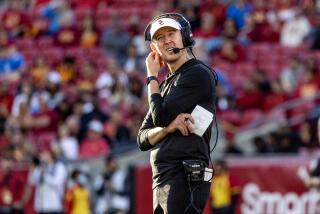AT&T;’S COURTSHIP OF NCR : Network Systems Help Make NCR an Attractive Target
- Share via
SAN FRANCISCO — NCR Corp., a century-old firm that made its name selling cash registers, has never been a first-rank player in the computer business.
But over the past several years, the quiet Dayton, Ohio-based company has succeeded in transforming itself into a profitable vendor of “open” computer systems, which use industry-standard hardware and software to allow computers from many different vendors to work together.
Indeed, it is NCR’s success in this fast-growing arena--combined with a strong sales and support organization, an excellent position in the market for retailing and banking automation systems and a significant presence overseas--that makes the company so attractive to American Telephone & Telegraph.
“NCR has figured out how to play in an open-standards world,” said John McCarthy, an analyst with Forrester Research, a Cambridge, Mass., consulting firm. “They’re poised to take advantage of the changes in the industry.”
Despite its strengths, NCR has suffered from stagnant revenue growth in recent years, and its long-term position in the volatile computer business is by no means assured. That could make it tough for the company to persuade shareholders that AT&T;’s $6-billion offer isn’t the best deal around.
Getting into the computer business in the first place was a wrenching change for NCR. Although the company had experimented with computer products as early as the 1950s, it wasn’t until the late 1960s--when the mechanical cash register business began to dry up--that it pursued the computer market in earnest.
Its approach, logically enough, was to focus on electronic cash registers and other “point of sale” computers for the retail and financial sectors. And it developed mid-size computer systems to link those terminals together and provide complete systems for bank branches, retailers and departments of large corporations.
The company never became a market leader in computers, but that has actually worked to its advantage in some respects. Companies such as Digital Equipment and Data General that specialize in mid-range computer systems have recently been battered as customers shift to networks of powerful personal computers. Meanwhile, NCR has taken advantage of its strength in areas such as terminals to position itself as a vendor of open computer networks.
“They don’t tend to be the headquarters computer. Their systems have to tie into the headquarters computer,” noted David Card, an analyst with International Data Corp. That has given the company some expertise in the now-critical area of linking networks of dissimilar computers and helped make it a leading supporter of the international computer networking standard known as OSI.
NCR was also an early proponent of Unix, an AT&T-developed; system for controlling the basic functions of a computer that has become an industry standard. While other mid-range computer companies continued to push machines that used proprietary operating systems--meaning that their computers were not compatible with others--NCR instead worked to move its customers from proprietary NCR systems to Unix-based NCR systems.
Currently, the company’s computer product mix includes three segments:
* Older, larger systems that use proprietary NCR components and software.
* Mid-range “Tower” products that use a Motorola microprocessor and run the Unix operating system.
* International Business Machines-compatible personal computers.
But the company recently announced a long-term plan to use Intel microprocessors--the type used by IBM PCs--for all its future products. The larger machines designed to run Unix would use multiple Intel processors, an increasingly popular technique called parallel processing.
NCR has taken a stake in a Los Angeles-based company called Teradata that makes a parallel processing machine, and it is also betting heavily on a new software package, called Cooperation, that integrates the operations of personal computers and the larger computer systems and “file servers” that often act as “hosts” for PCs.
Robert Kidd, an analyst with the market research firm Dataquest, noted that the planned product transition left NCR “between two worlds in terms of hardware, and that’s always dangerous.” And he said the company has not been that successful in switching its customers from older proprietary systems to newer open ones.
But the core business in retail and banking terminals remains strong--those two areas accounted for $1.4 billion in revenues last year--and NCR has a broad enough customer base to have done more than $2 billion in support and service business last year. PCs, by contrast, were a $400-million business for NCR, and multi-user computer systems totaled $850 million.
NCR At A Glance In addition to computers, the Dayton, Ohio-based company makes automated teller machines and sophisticated variations on the cash register-it’s original line of business. In the early days of computers, NCR was one of the first-tier companies. Revenue in bilions of dollars 1987: $5.64 1988: $5.99 1989: $5.96 Net Income in millions of dollars 1987: $419 1988: $439 1989: $412 Total assets: 4,500 Number of employees: 56,000 Common shares outstanding: 69.25 million 12-month stock price range: $44.50-$72.25 Monday close (NYSE): $81.50, up $24.75 Source: Standard & Poor’s GLOBAL COMPUTER SALES
1989 sales Company/country (billions) 1.IBM/U.S. $62.7 2.Digital Equipment/U.S. 12.7 3.Fujitsu/Japan 11.9 4.Unisys/U.S. 10.1 5.NEC/Japan 10.0 6.Hitachi/Japan 9.8 7.Hewlett-Packard/U.S. 8.1 8.Olivetti/Italy 7.3 9.Bull/Italy 6.5 10. NCR/ U.S. 6.0
Source: Dataquest
More to Read
Inside the business of entertainment
The Wide Shot brings you news, analysis and insights on everything from streaming wars to production — and what it all means for the future.
You may occasionally receive promotional content from the Los Angeles Times.








